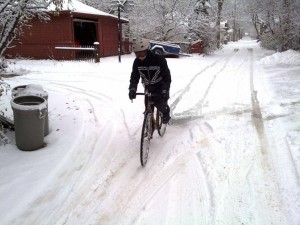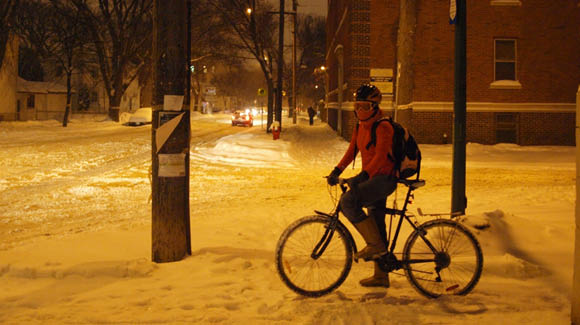
Photo: Green Action Centre by permission
With the pending change from fall to winter you may be thinking your cycling will soon be done for the year. Cycling through winter and navigating those snow covered streets is challenging, but if you plan and dress for it, you can successfully keep on riding your bike. Here are a few key areas to think about:
- Safety
- Planning your ride and the route that you plan to take
- Dress for the conditions
- What kind of bike/equipment you need
- Maintaining your bike so that it operates in both the cold and slushy weather
Safety
Safety is of prime importance whenever you ride, however, in the winter months there are some specific issues you need to prepare for. Traction is likely the first thing that comes to mind (see bike and equipment below). Visibility is also a significant area to consider. With reduced daylight hours you are often cycling in the dark. Here are some tips to ensure you are seen:
- Wear bright clothing with reflective strips or a reflective vest.
- Add a pair of reflective bands around your ankles and wrists. The ankle bands will always be in motion and the wrist bands will make your signals more visible.
- Equip your bike with LED lights both front and rear. Adding a solid white light (to light your path) on the front is a good option too.
- Add a reflector and/or reflective tape to your bike in case your light doesn’t work
Route planning
Re-think your route. The route that you used all summer long might not be the best fit for the winter. Main arteries are plowed, but can become very slippery when polished up by heavy traffic. Of course you don’t want to have to be slogging through heavy snow either! Plan your route considering the conditions on that day, and allow extra time both to get dressed and for the ride itself.
It is also a good idea to get to know the potential hazards along you routes as well. This can be very helpful especially when those potential hazards are not visible due to snow cover.
Dress
Dressing for cycling in the winter is much the same as dressing for any outdoor activity – layers. Here are a few basic tips on dressing for your winter commute by bike:
- Follow the basic layering principles – a perspiration wicking undergarment, an insulating layer, and a wind-proof shell
- Use lightweight materials wherever possible to reduce bulk
- The shorter your ride, the warmer you likely need to dress – longer rides allow you to work up some warmth
- Wear a balaclava, toque, mask, neck tube or combination to keep you head and face warm. Ski goggles are a great addition and generally don’t fog up like glasses.
- Tape over the vents on your helmet or add a helmet cover. There are also ski helmets and other helmet options that have less venting that work really well.
- Wear gloves or mitts that allow for some dexterity to operate your brakes. There are lots of options for your hands including pogies which attach to your bike handlebars and keep your hands from being exposed to the elements while still giving you access to your brakes and shifters.
Bike and Equipment
The types of bikes used for winter riding are as varied as the riders themselves. Here are a few things to consider:
The Bike
- The wet sand and salt of winter are hard on your bike so you might want to consider an older bike.
- Beware of inexpensive department store bikes as the lower quality components are not meant for the extremes of winter riding.
- Whatever bike you chose needs to prepared and maintained so that it performs well under winter conditions. Check with your local bike shop or any of the community bike shops (see The WRENCH) for some advise and/or service.
- Consider converting your bike to a single speed (either a single fixed gear or simply using only 1 gear on your existing free wheel or cassette). Derailleurs seldom work for long under winter conditions without constant care and lubrication.
- Studded tires are not always necessary in winter, but there are times when they can be a great benefit, especially on the front wheel. There are a number of different types including some that bike shops make up themselves. You might even consider making your own, but its best to talk to other winter cyclists before deciding which way to go. You want to consider traction, but also puncture resistance (who wants to change a flat in the cold) and rolling resistance.
- If you are considering a new bike or components, make sure to get the facts on the best options for winter riding. Options like sealed cartridge bearings can save you a lot of maintenance and reduce the potential for costly repairs.
Other Equipment
- Add full fenders for those sloppy days
- Narrower knobby tires tend to cut through the snow rather than float on top.
- Studded tires are an option and perform considerably better on ice, however they can be expensive and will wear quickly on bare pavement.
Maintenance
Keeping your bike’s drive train lubricated is an important part of winter maintenance. Unfortunately winter tempertures generally restrict cleaning to the use of a rag or brush. Here are some tips on cleaning and lubricating your drive train:
- Light lubricants specific to bicycles work best in colder temperatures.
- Never use solvents to clean your chain. In winter just wiping any build up off is sufficient.
- Lubricate liberally and regularly.
- Make sure to wipe off the excess lubricant as it will only attract more salt and sand.
- Multi-gear systems will need to be cleaned more frequently. Make sure to lubricate all the moving parts on the derailleurs so that they continue to function.
Rust is also a significant concern, especially in wet, sloppy conditions. Keeping your bike clean in winter can be a challenge. Brush away snow and ice from your brakes and drive train after each ride. Wipe your bike down regularly to reduce salt build-up. If the temperatures are such that you can wash your bike, bring it inside to dry off so the brakes and drive train components do not freeze up. Before you ride again, make sure to lubricate as indicated above.
Riding a bike through winter results in the need for some extra attention to maintenance come spring. If you are even a little mechanically inclined you can learn to do most of the work yourself. Consider taking a course (see the links below) or use on-line resources to learn more about how to care for your bike. Bikes do not have to be disposable, just maintained.
More info
- Icebike
- Bicycling Life
- Cold Weather Cycling (Toronto Bicycle User Group)
- Bike Winnipeg (Manitoba)
- Natural Cycle – Winter Cycling tip sheet
Check with The Wrench, Bike Dump and Natural Cycle for free winter riding skills and equipment workshops.




Recent Comments